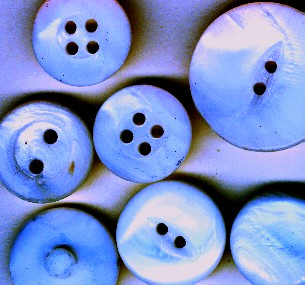
|
It is difficult to
determine the provenance of shell buttons with
certainty. If anyone has specific information on
this subject, please contribute. Additionally,
they do not scan well, as colors are muted and
vary in subtle shades of white.
Freshwater mussels are the most likely
source for those on the left, above,
and further contrast-enhanced left,
based on the presence of a pallial line structure
visible within the nacre in some. The sheen is
silvery, and the play of diffraction colors is
almost absent in most freshwater shell.
Many of those in the center,
above, show a white layer with pinkish markings.
Others have nacre identical in color and texture
with those with markings. Color is somewhat
yellowish, diffraction colors are stronger and
"grain" is more uniform. These may come
from a marine turban shell, Trochus
niloticus L., 1767.
Finally, the majority of buttons, above
right, come from unidentified sources
which may include the thinner nacreous parts of
freshwater mussel shells, marine mussels, pearl
oysters, jingle shells, and a variety of other
species. Some are gray and relatively opaque. The
two small ones at the bottom of the assemblage
are characterized by a distinctive linear
structure within the grain of the shell.
|